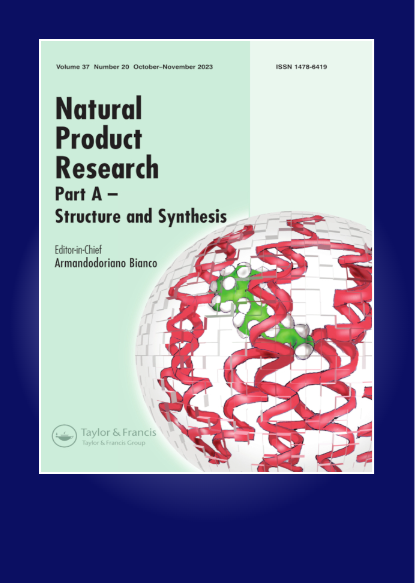Unveiling the healing properties of 2,3-dehydrosilychristin: a potential silymarin-derived flavonolignan from Vitex negundo
IF 1.9
3区 化学
Q3 CHEMISTRY, APPLIED
引用次数: 0
Abstract
The compound 2,3-dehydrosilychristin, a flavonolignan linked to silychristin and silymarin, remains intriguing due to its challenging isolation from silymarin. While silymarin has been the exclusive source of flavonolignans – silybin, silychristin and silydianin − 2,3-dehydrosilychristin is reported in this study from Vitex negundo Linn. leaves. 2,3-Dehydrosilychristin (7) and 14 other compounds were isolated through focused extraction. Its subsequent pharmacological evaluation demonstrated potent antioxidant and in-vitro anti-inflammatory effects, notably inhibiting cytokines TNF-α, IL-6, IL-8 and VEGF. In in-vivo assessments, 2,3-dehydrosilychristin (7) revealed remarkable hepatoprotective potential by reducing liver enzyme levels AST and ALT. These findings expand the potential of 2,3-dehydrosilychristin and suggest bioprospecting Vitex species as alternate sources of bioactive flavonolignans.
揭示 2,3-dehydrosilychristin 的治疗特性:一种从荆芥中提取的潜在水飞蓟素黄酮木脂素。
2,3-脱氢水飞蓟素是一种与水飞蓟素和水飞蓟素相关联的黄酮木脂素化合物,由于其从水飞蓟素中分离出来的难度很大,因此这种化合物仍然令人好奇。水飞蓟素一直是水飞蓟宾、水飞蓟素和水飞蓟二甙等黄酮木脂素的唯一来源,而本研究报告的 2,3-脱氢水飞蓟素则来自黑荆叶。通过集中萃取,分离出了 2,3-脱氢水飞蓟素(7)和其他 14 种化合物。随后进行的药理评估表明,该化合物具有很强的抗氧化和体外抗炎作用,尤其能抑制细胞因子 TNF-α、IL-6、IL-8 和血管内皮生长因子。在体内评估中,2,3-脱氢肉毒碱(7)通过降低肝酶 AST 和 ALT 水平,显示出显著的保肝潜力。这些发现拓展了 2,3-脱氢水飞蓟素的潜力,并建议将荆属植物作为生物活性黄酮木脂素的替代来源进行生物勘探。
本文章由计算机程序翻译,如有差异,请以英文原文为准。
求助全文
约1分钟内获得全文
求助全文
来源期刊

Natural Product Research
化学-医药化学
CiteScore
5.10
自引率
9.10%
发文量
605
审稿时长
2.1 months
期刊介绍:
The aim of Natural Product Research is to publish important contributions in the field of natural product chemistry. The journal covers all aspects of research in the chemistry and biochemistry of naturally occurring compounds.
The communications include coverage of work on natural substances of land and sea and of plants, microbes and animals. Discussions of structure elucidation, synthesis and experimental biosynthesis of natural products as well as developments of methods in these areas are welcomed in the journal. Finally, research papers in fields on the chemistry-biology boundary, eg. fermentation chemistry, plant tissue culture investigations etc., are accepted into the journal.
Natural Product Research issues will be subtitled either ""Part A - Synthesis and Structure"" or ""Part B - Bioactive Natural Products"". for details on this , see the forthcoming articles section.
All manuscript submissions are subject to initial appraisal by the Editor, and, if found suitable for further consideration, to peer review by independent, anonymous expert referees. All peer review is single blind and submission is online via ScholarOne Manuscripts.
 求助内容:
求助内容: 应助结果提醒方式:
应助结果提醒方式:


